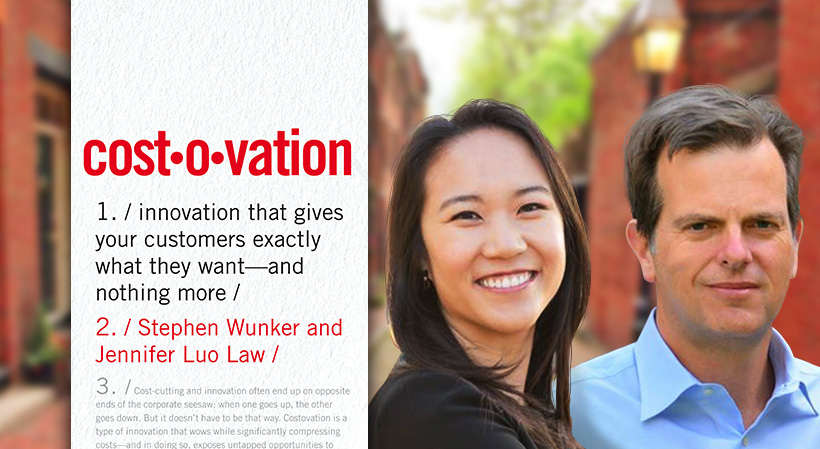The following is excerpted from “Costovation” by Stephen Wunker Copyright © 2018 by Stephen Wunker. Used by permission of HarperCollins Leadership. www.harpercollinsleadership.com.
What costovation is and why it matters
Aside from its electrifying bright purple and yellow decor, Planet Fitness looks like any other gym: There are rows and rows of elliptical machines and treadmills. There’s a basic locker room. The current top-40 hits are pumping over the speakers.
But on closer inspection, you’ll notice that there is actually a lot missing from this gym. There are no studios for yoga or spinning. There isn’t a heavy-free-weight section. There aren’t even any personal trainers. In fact, Planet Fitness forgoes many common gym features, such as:
- Towels
- A pool
- A basketball court
- Childcare
- Steam rooms, hot tubs, and saunas
- Free Wi-Fi
Even the typical gym-membership price tag is missing: while the average gym charges $52 a month, a basic Planet Fitness membership costs just $10.
But Planet Fitness is not simply a story of a company trying to make a quick buck by slashing services and lowering prices. To understand the secret of Planet Fitness’s success, we need to look at how lowering costs and simplifying services can be a deliberate innovation strategy—one whose aim is to make the fitness experience more satisfying to its customers, not less.
Planet Fitness members don’t feel shortchanged by their bare-bones gym. They love that there are rows and rows of cardio machines, which means that they never have to wait to start their workout. And they don’t miss the heavy weights: Planet Fitness’s target customers don’t care for those anyway. Lunch-time workouts are stress-free without personal trainers trying to sell them services. The Planet Fitness model is cheaper to run than anything else on the market, but it still ranks first in customer satisfaction—even ahead of luxury giants like Equinox. And the company keeps growing; at last count, Planet Fitness boasted over 7.3 million members working out in over 1,100 North American locations.
This is a company that has made careful, and sometimes difficult, choices to have a simple, low-cost offering. Along the way, it sacrificed temptations that lure other gym chains—such as personal trainers, a highly profitable add-on service that for most gyms brings in close to 10 percent of total revenue, or passive sources of income like rent from massage and physical therapists.
Planet Fitness’s success highlights an under appreciated approach to innovation: purposefully offering less as a way to satisfy more.
Rather than trying to compete in the overcrowded luxury fitness field, with its lavish services and hefty price tags, Planet Fitness found opportunity with a customer segment that most gyms rule out as unprofitable—casual and first-time exercisers. It then focused on a handful of things that these customers most prize, such as offering reliable workout equipment, with 24/7 access, at consistently low rates. That’s all. The company chops out the usual profit-making mechanisms adored by the industry. It seeks customers most gyms avoid, because its low operating costs make those customers far more attractive to it than to rival chains. While the rest of the fitness industry continues to plow upmarket, Planet Fitness forges its own very successful path with a no-nonsense business model that delights its boardroom as much as its customers.
This is low-cost innovation, or costovation, hard at work.
Related: The Benefits of Encouraging Creativity and Innovation in the Workplace
What is costovation?
Costovation is a type of innovation that significantly compresses costs while still wowing customers.
It’s about meeting or exceeding customer expectations with less.
Planet Fitness, with its low costs and slim offerings—but ecstatic customers—is an example of costovation. Ryanair, an ultra-budget European airline which at one time tried to charge customers for drinking water and bathroom use, is not. The difference is in customer experience. Ryanair tickets can be a grudge purchase, and purchases made with gritted teeth don’t often lead to ever-thriving companies.
To get a better sense of costovation, let’s look at an example from the hospitality industry. If you’ve ever been stuck on a six-hour layover, you know your options for comfort are bare: you can get in line for a shuttle to a local airport hotel (and plunk down your credit card for an entire night’s stay), or you can cozy up to a worn-out chair in the airport terminal. Both of those options are depressingly unappealing, especially for the frequent traveler. Enter Yotel.
Yotel is a hotel chain found in international airports like London’s Heathrow and New York’s JFK. Accommodations are often directly on-site within airport terminals, and rooms are extraordinarily small, fitting just a bed and an airplane-like bathroom.
But for time-conscious travelers, Yotel offers exactly what they crave—a comfortable bed, an excellent shower, strong Wi-Fi, proximity to their next flight, and fast check-in.
Yotel doesn’t really offer much more than that, yet it’s become quite popular with experienced travelers. This travel segment is not looking for extra amenities such as a tub, a gym, or a pool. And by keeping things simple, Yotel’s back-end operations can be exceptionally lean. It uses automated kiosks for check-in and food vending, and it makes the most of its prime real estate by shrinking room sizes to tiny pod-like cabins. These cost savings enable Yotel to offer rooms that are much cheaper than a typical hotel—cheap enough that travelers use it during long layovers. At the same time, Yotel exceeds competitive offerings in critical ways, such as by providing monsoon showers for customers looking to de-grime after a long flight. Yotel runs a low-cost model, but it still nails the core needs of long-haul travelers looking for a quick place to rest and freshen up.
Many industries need a Yotel—a company that excels at offering something at a radically lower price, for a well-defined customer set. We’ve seen an increasing number of costovations in recent years, and as we’ll soon see, they are often enviably simple in nature.
Sign Up: Receive the StartupNation newsletter!
Breakthrough perspective
In 2012, John Zimmer was running a carpooling startup with his best friend Logan Green when they asked themselves a fateful question: If we could do this all over again, how would we do it?
It wasn’t that their company was failing. Actually, the opposite was true. Zimride—named not for Zimmer but for Zimbabwe, where the business idea was hatched—had grown at a steady clip in the 5 years since it was founded. It had coordinated carpools for tens of thousands of students at over 125 university campuses, saving a collective $50 million in vehicle-operating expenses. The website had $7.5 million in venture funding and 29 employees. It was turning a profit.
But the question still loomed over the Zimride founders’ heads: What would we do if we were starting over today?
What was true in 2012 that had not been true in 2007?
Many things were of course different, but there was one trend in particular that would come to transform the Zimride founders’ fortunes: the proliferation of smartphones. With smartphones, carpooling went from being something that you scheduled days in advance, to something that you hailed on demand—a revolutionary costovation that made transportation both cheaper and a better experience.
You likely haven’t heard of Zimride, but you’ve certainly heard of Zimmer and Green’s second company: Lyft. Five years after Zimmer and Green had their brainstorming session, Lyft was valued at $5.5 billion.
Breakthrough innovation begins with breakthrough perspective. If you see the market in the same way that your competitors do, then you will solve problems in the same way that they do too. But if you can honestly answer tough questions—like the Lyft founders did about Zimride—you can discover seedlings of new opportunities that have only just broken ground. You can identify areas that are underserved and processes that are redundant. You can find weak points that are ripe for disruption.
“Costovation” is available now at fine booksellers and can be purchased via StartupNation.com.






